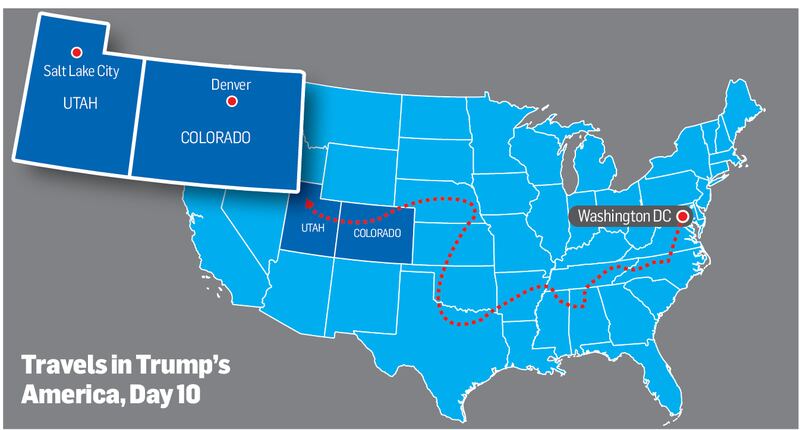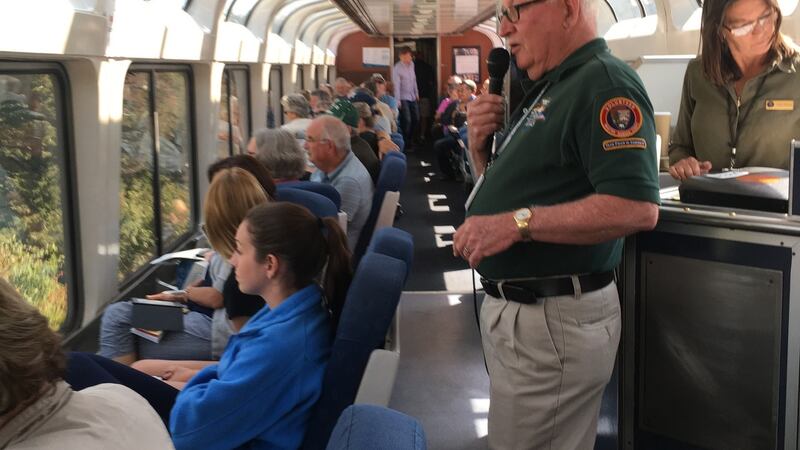In the 10th part of her series “Coast to Coast: Travels in Trump’s America”, Washington Correspondent Suzanne Lynch heads west over the Rocky Mountains
Every afternoon as the clock strikes two, the Amtrak Zephyr train pulls out of Chicago's Union Station and begins its three-day journey west across the United States.
Time doesn’t matter much on this meandering journey through America’s mid-west. In a country where the car rules, taking the train is an opportunity to step outside the regular schedules and deadlines that drive American life.
I join the train at 8am in Denver, at the foothills of the Rocky Mountains. It is running two hours late, but no one seems to mind. As the cheerful attendant explains, the big freight trains that carry coal, oil and other goods forward and back across the US own the railtrack, and the passenger trains play second fiddle. Once the Amtrak Zephyr misses one slot, there may be no recovery. Some of the trains arrive a day late in California.

I settle down for the first leg of my 15-hour journey from Denver to Salt Lake City, Utah, in the surprisingly spacious coach carriage. I plan to spend much of the journey writing but instead I spend most of the morning chatting with my neighbour, a friendly woman from rural Illinois who is travelling with her husband and son.
She is on the way to her father’s 90th birthday. Her parents moved to the picturesque town of Grand Springs in the far west of Colorado, and she frequently takes the train to visit them. “It’s just easier than the hassle of the plane, and the scenery is spectacular,” she says.
Landscape idiosyncrasies
As the train makes its ascent and winds through the Rocky Mountains, she points out features of the journey, proud to be showing off the best of her country. The scenery is breathtaking and she points out some of the idiosyncrasies of the landscape that only the regular traveller will spot – the old abandoned rail cars that are lined up along the sides of the track to act as snow and wind-breakers in the winter; the tiny yellow crop-duster planes that circle high above the mountains en route to the prairies where they will spray the land from the air.
Within a few hours we pass through our first canyon as we continue west towards Utah, and dramatic cliff faces and gorges replace the mountain peaks of the Rockies.

Two coaches down in the viewing car, an Amtrak staff member is relaying the history of the region on a microphone. I speak to one man who has been on the train 11 times each way – an amateur historian, he has spent his time travelling around the country by train since retiring.
It’s time for lunch, and I move to the dining-car. My two dining companions are both Americans – a librarian from Sacramento, California, and a banker from Chicago.
Bill is on his way to a family vacation he has organised in Lake Tahoe, California. Both his daughters live in San Francisco and he’s hoping they’ll join him there. Serena has just been visiting her daughter, who lives in a small town in Illinois, and is on her way back home.
As we sit over a leisurely lunch watching the ever-changing scenery slowly playing out behind us, we talk about the state of the country. Bill, the more loquacious of the two, is happy to talk about politics. As the subject inevitably turns to Trump, he laughs. “Those tweets,” he says, as he throws his hands up in the air.
Principle of hard work
But as the conversation continues it becomes clear that he is a Republican. He lived in London for six years, and he says that in many ways he felt that living in Britain was like living in a socialist country. He says he believes in the Republican principles of the free market, of individualism and the principle of hard work.
'Oh my God, I want to apologise for our president,' she says when she hears I'm from <a class="search" href='javascript:window.parent.actionEventData({$contentId:"7.1213540", $action:"view", $target:"work"})' polopoly:contentid="7.1213540" polopoly:searchtag="tag_location">Ireland</a>
Like many traditional Republicans I have met in this country, he voted for Trump, despite reservations about him. As he continues, Serena grows quiet and picks at her food. It is obvious she does not share his views, but no one wants a political debate. We change the subject and look out at the scenery.
Like places all across America – in families, in workplaces, among friends – Trump and the state of this nation is a topic that divides people.
After lunch, I return to my seat and have a new travelling companion – Petra, a woman in her 30s from Sonoma County in California. "Oh my God, I want to apologise for our president," she says when she hears I'm from Ireland. "He's an embarrassment. You know many of us in California want to secede?"
She settles back to her book.
As the sun lengthens and late-afternoon approaches, we cross the border into Utah. The landscape shifts dramatically. Ahead of us stretch miles and miles of uninhabited desert, bathed in the early-evening light. Huge cliffs jut out of the dry, red soil.
Defining moment
The completion of the Pacific Railroad, linking the east coast of America to the West, in the late 1860s, was a defining moment in American history, opening-up the vast landscapes of Nebraska, Utah and Nevada to settlers and pushing the American frontier further west. Today, the journeys of those early settlers, many of them Irish, working to complete the railroad in the remote, dry heat of the desert, seem close. So too is the presence of the native American communities whose existence was all but erased from the landscape as they were forced south, mostly to Oklahoma.
As the sun begins to set, our train track runs alongside the I-80 interstate, empty apart from the odd pick-up truck and motorbike that drive by against a dramatic backdrop of mountains and cliffs.
Suddenly our little train with its eclectic blend of people thrown together, seems small and insignificant as the expansive landscape stretches out ahead.













